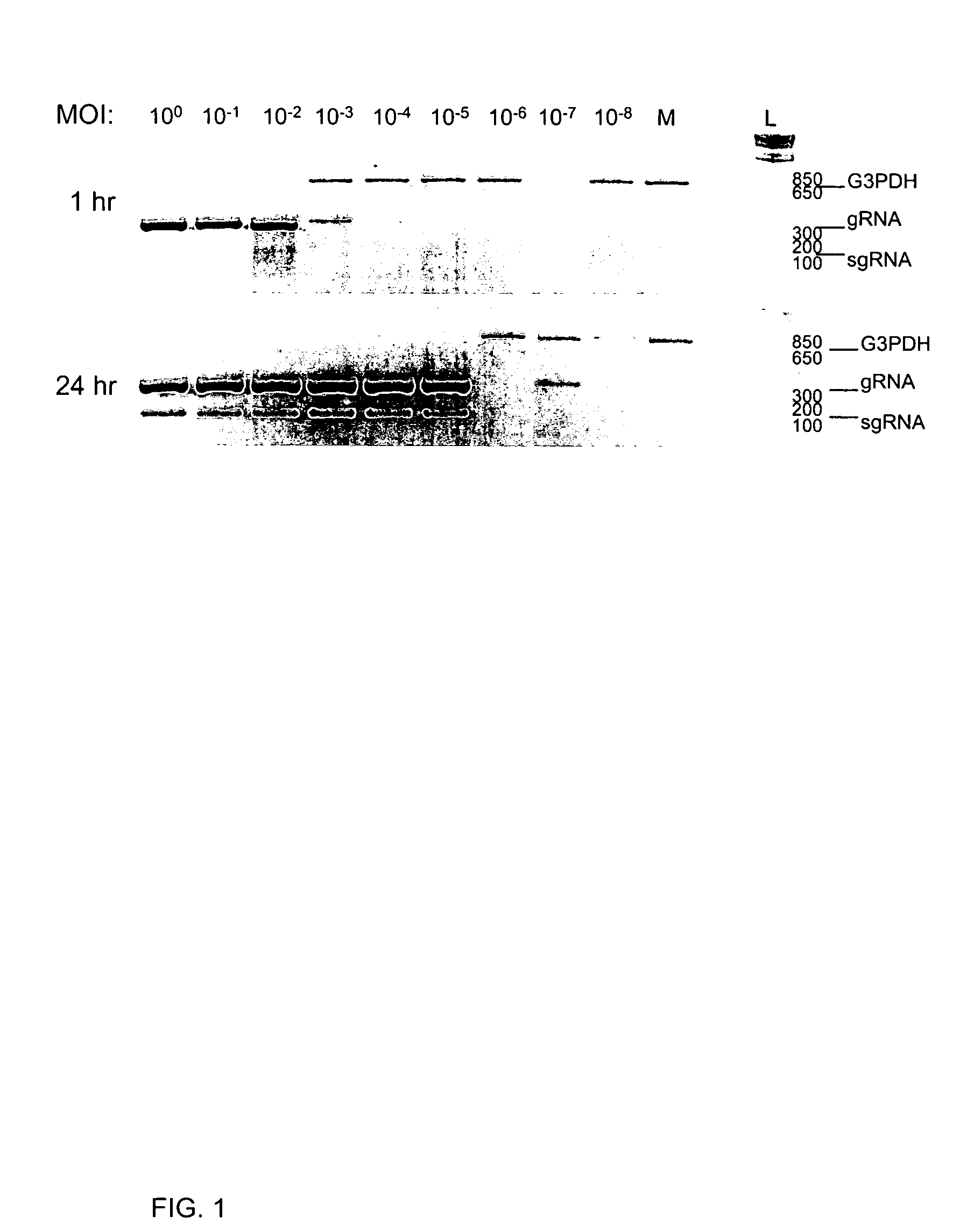Compositions and methods for detecting severe acute respiratory syndrome coronavirus
a coronavirus and severe acute respiratory syndrome technology, applied in the field of coronavirus composition and methods for detecting severe acute respiratory syndrome coronavirus, can solve the problems of insensitive identification of sars-cov or abortive replication, laborious methods, misleading results, etc., to reduce the level of sars-coronavirus sgrna, reduce the ratio of sars-coronavirus sgrna, and reduce replication
- Summary
- Abstract
- Description
- Claims
- Application Information
AI Technical Summary
Benefits of technology
Problems solved by technology
Method used
Image
Examples
example 1
Materials and Methods
[0278]The following is a brief description of the exemplary materials and methods used in the subsequent Examples.
A. Virus
[0279]A seed stock of SARS-CoV Urbani that was passaged twice in Vero E6 cells provided by the Centers for Disease Control and Prevention, Atlanta, Ga. This virus was amplified by two passages in Vero E6 cells to establish a high titer stock (passage 4) that was utilized for all experiments. SARS-CoV was titered in Vero E6 cells by TCID50. Briefly, cells were plated in 96-well plates (Falcon, Becton Dickson) at a density of 4×105 cells / well in 150 μl of medium. Virus was serially diluted by half logs from 100–10−7 in culture medium containing 2% antibiotic-antimycotic (Invitrogen Corporation, Carlsbad, Calif.). 100 μl of each dilution was added per well and cells were incubated 3–4 days at 37° C.
B. Cell Lines
[0280]The following Table lists exemplary cell lines that were used and / or equivalent cells that may be used in the invention's methods,...
example 2
Exemplary Multiplex RT-PCR Assay for the Detection of SARS-CoV Replication
[0285]A RT-PCR assay for the detection of SARS-CoV replication was developed. Replication of corona- and arteri-virus RNA occurs through discontinuous synthesis, thought to occur during negative strand synthesis, generating 3′ co-terminal nested subgenomic RNAs (sgRNA). The inventors identified targets within the genome for amplification. Oligonucleotide RT-PCR primers were designed that amplify genomic SARS-CoV RNA (gRNA) or the sgRNA that is specific to the leader-body junction. Because genomic RNA is present in input virus, the inventors probed for sgRNA, which is indicative of virus entry and / or replication initiation. Genomic RNA was detected by amplifying a region between the 1b coding region of the polymerase gene and the sequence encoding the Spike (S) glycoprotein. Subgenomic RNA was detected using a primer specific to the leader sequence in conjunction with the reverse primer in S that was used for t...
example 3
Primary Monkey Kidney Cells pRhMK and pCMK are Susceptible and Permissive to SARS-CoV
[0288]To test the specificity of the RT-PCR assay and to identify cells susceptible to SARS-CoV, kidney cells derived from two species of monkey were inoculated with SARS-CoV at an MOI of approximately 0.001. Vero E6 cells were included in all experiments as a positive control. Entry and early replication of SARS-CoV was detected in primary Rhesus monkey kidney cells (pRhMK) and primary Cynomolgous monkey kidney cells (pCMK) at 24 and 48 h p.i. (FIG. 2A). SARS-CoV genomic RNA was detected at 1 h p.i. and increased by 24 and 48 h p.i. In both cell types, sgRNA, absent from input virus (1 h) was detected at 24 and 48 h p.i. Once again, G3PDH amplification decreased as the amplification of viral RNA increased. Subgenomic RNA was not detected in inoculated baby hamster kidney cells (BHK-21), included as a negative control. In these cells, gRNA was detected only in the viral inoculum (1 h). Both pRhMK an...
PUM
| Property | Measurement | Unit |
|---|---|---|
| volume | aaaaa | aaaaa |
| volume | aaaaa | aaaaa |
| temperature | aaaaa | aaaaa |
Abstract
Description
Claims
Application Information
 Login to View More
Login to View More - R&D
- Intellectual Property
- Life Sciences
- Materials
- Tech Scout
- Unparalleled Data Quality
- Higher Quality Content
- 60% Fewer Hallucinations
Browse by: Latest US Patents, China's latest patents, Technical Efficacy Thesaurus, Application Domain, Technology Topic, Popular Technical Reports.
© 2025 PatSnap. All rights reserved.Legal|Privacy policy|Modern Slavery Act Transparency Statement|Sitemap|About US| Contact US: help@patsnap.com



